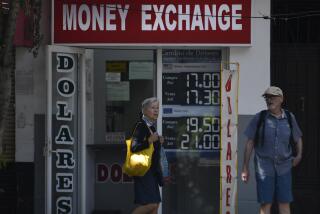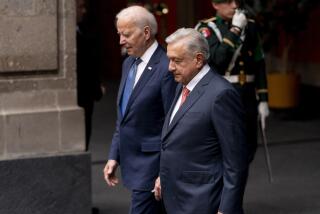Off 50% at Border Exchange : Peso’s Value Dives as Mexico’s Central Bank Cuts Off Dollars
- Share via
MEXICO CITY — The free-market value of Mexico’s currency fell sharply against the dollar Wednesday as Mexico’s central bank cut off supplies of dollars to Mexicans who are eager to convert increasingly devalued pesos into U.S. money.
The surprise move by the Bank of Mexico came in the wake of the stock market collapse here and a series of troubling reports about the Mexican economy.
The Bank of Mexico stopped injecting dollars into the free market Wednesday and would sell dollars only on the so-called controlled market, which is for import-export transactions. The bank maintained an official rate of exchange of 1,705 pesos to the dollar in the controlled market, a rate only slightly higher than Tuesday’s official closing. The controlled market accounts for about 80% of foreign exchange transactions in Mexico.
The central bank’s decision to dry up the free-market supply of dollars drove up the price of the U.S. currency wildly in the country’s nationalized banking system and private exchange houses.
It took 2,025 Mexican pesos to buy a single U.S. dollar at Mexican banks. The day before, buyers needed only 1,713 pesos to purchase a dollar. The difference amounted to a free-market devaluation of 16% in a single day. Banks quickly ran out of dollars and stopped selling them by midday.
The decline was even steeper in private exchange houses. On Wednesday, the cost of a dollar reached 2,500 pesos, compared to 1,714 on Tuesday, translating into a decline in the peso’s value of 31%. Some exchange houses closed their windows to business early in the day.
And along the U.S.-Mexico border, the peso’s value dropped still further. In San Ysidro, the border area of San Diego, dealer Francisco Anzar said the peso’s value had declined 50% by late Wednesday afternoon on his exchange--3,450 pesos bought a dollar, up from 1,700 at the beginning of the day--before he suspended dollar sales.
A clash of economic interests between the government and skittish private citizens apparently prompted the Bank of Mexico to withhold dollars from the open market, economic experts say. During the past few months, Mexicans have been stepping up purchases of dollars as a hedge against economic stagnation and inflation in Mexico. Suddenly, the government, seeing a need to stem capital flight, stopped injecting money into the free market to meet the demand.
“The demand for dollars was too big. The government wants to keep money in the country,” said Sidney Wise, who publishes an investment newsletter in Mexico City.
For most of the past five years, Mexico has tried to even out the devaluation of the peso on both the free and controlled markets to avoid sudden declines and panic. If it wants to intervene, the Bank of Mexico holds plenty of resources; in September, its dollar reserves were reported at nearly $15 billion, a record.
Although the refusal to supply dollars to the free market reflected a change in foreign exchange policy, neither the government nor the Bank of Mexico offered much explanation. Armando Basurto, a central bank spokesman, said only that the activity on the free market did not mean that the currency would be officially devalued.
He added that the steep decline at private exchange houses was “lunacy.”
Customers hunting for dollars Wednesday were taken aback by the sudden downturn in the value of their money and feared that worse times may be in store. “People are saying the peso could fall to 5,000 (to the U.S. dollar), so I’m trying to buy now,” said Eduardo Sanchez, 42, a lawyer queued up at Casa de Cambio Genova on Reforma Boulevard, Mexico City’s main street.
“This is a crass stupidity,” added Ana Maria Carrizalez, 48, who was changing pesos into dollars to finance a vacation to the United States. “They have changed the value in an ugly way.”
Private money exchangers were left in confusion. “We don’t know what to do,” said a private trader on Reforma. “Apparently, there are no dollars around because the banks will not sell us any. We’ve been receiving a lot of calls from people wanting to buy dollars, and we’re turning them away.”
The fall in the free-market peso follows a parade of grim economic news here in the past few days.
Earlier this week, the Mexico City stock market continued to fall after a plan to shore up prices, announced by government banks and private brokerage houses, disintegrated. As of Tuesday, the market had lost more than 70% of its value since the worldwide Black Monday of Oct. 19, but it rebounded sharply Wednesday.
Some brokers attributed higher market prices Wednesday to the possibility that a fall in the controlled rate of the peso will follow the decline in the free market rate, thus stimulating exports.
This week, the government raised interest rates on the money it borrows to cover chronic budget deficits. The move was meant to encourage Mexicans to invest in Mexico rather than send their money abroad, but the measure was also seen as a sign that inflation is getting out of control.
The government has estimated that in 1988, consumer prices will increase by more than 90%; for this year, the inflation rate is running at about 140%. A planned increase in the price of gasoline this month was postponed indefinitely to calm public nerves.
Meanwhile, the Mexican economy will grow very little this year, perhaps no more than 1%, expert observers say. That is less than half the growth predicted by the government at the beginning of 1987.
“There is no happy economic outlook,” economist Jorge Castaneda said. “The best the government can do is try to hold things together.”
Castaneda estimated that in recent weeks, the amount of money put into U.S. dollar bank accounts abroad by Mexicans may have exceeded $1 billion. That would reverse a yearlong trend that saw them bring back money from abroad and put it in bank accounts and stocks here.
“We’re seeing a revival of capital flight,” said economist Rogelio Ramirez de la O. “In the U.S., when the stock market collapsed, people put money in banks or bonds. Here, there is no confidence in such instruments. Mexicans want to have their money in dollars.”
The value of the peso has fallen from 350 to the dollar in 1985 to its current level of more than 2,000 pesos to the dollar on the free market.
More to Read
Sign up for Essential California
The most important California stories and recommendations in your inbox every morning.
You may occasionally receive promotional content from the Los Angeles Times.










